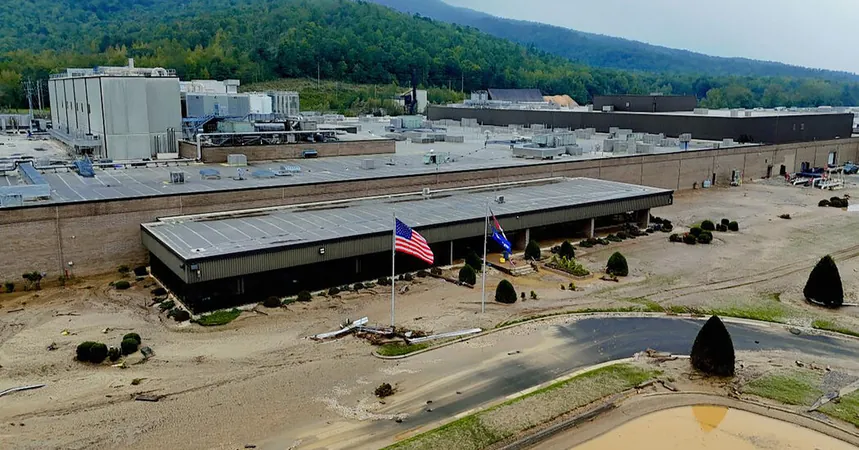
Urgent Efforts Underway to Address IV Fluid Shortages as Hurricanes Devastate Supply Chains
2024-10-09
Author: Chun
Urgent Response to IV Fluid Shortages
In a race against time, U.S. health authorities have initiated airlifts of vital intravenous (IV) fluids from overseas manufacturers, attempting to mitigate a severe shortage precipitated by Hurricane Helene. This crisis has forced many hospitals to postpone surgeries, prioritizing supplies for their most vulnerable patients.
Manufacturing Impact Due to Natural Disasters
The heart of this shortage can be traced back to significant flooding in western North Carolina, which ravaged a Baxter manufacturing plant that produces approximately 60% of the country's IV fluid supply. This facility is now closed for cleanup, leaving healthcare facilities scrambling for resources critical for the care of premature infants, patients relying on in-home dialysis, and individuals dependent on IV nutrition.
Threat of Further Disruption
The situation is poised to deteriorate even further as Hurricane Milton threatens to impact Florida. In a proactive measure, workers at B. Braun’s facility, responsible for about 25% of the nation’s IV fluids, have been relocating critical supplies to safer locations.
Warnings About Supply Concentration
Experts have long warned about the risks associated with the over-concentration of essential medical supplies, citing natural disasters as a key vulnerability. Even prior to Hurricane Helene, the medical community faced a tight supply environment due to minimal competition in producing low-cost medical products.
FDA Measures to Address the Crisis
In a bid to stabilize the situation, the Food and Drug Administration (FDA) announced on Wednesday that they have authorized imports of IV products from Baxter plants located in Canada, the United Kingdom, Ireland, and China. Baxter has also reduced its hospital distributions to a mere 40-60% of normal levels, as they tackle the fallout from the flooding.
Types of Affected IV Fluids
The types of fluids impacted include saline, dextrose, and sterile water, which are crucial for various medical applications such as hydration before procedures, treatments for sepsis, and life-sustaining nutritional support for at-risk patients. Individuals like Hannah Hale from Texas, who has relied on IV nutrition for eight years due to complications from Crohn's disease, are anxiously awaiting solutions. After learning her pharmacy could not fill her prescription, she spoke to 14 others to no avail, expressing her desperation.
Healthcare Facilities Implementing Conservation Measures
Healthcare facilities are scrambling to implement IV fluid conservation measures as the crisis unfolds, with organizations like Texas Health noting a proactive approach to manage their inventory. Meanwhile, the U.S. Department of Health and Human Services is actively working with Baxter to ensure the safety of workers and address the urgent supply shortages.
Longstanding Issues in Healthcare Supply Chain
The fallout from these hurricanes shines a light on a longstanding issue within the healthcare supply chain. The challenges faced during the COVID-19 pandemic, such as having inadequate supplies and severe shortages of essential drugs, have amplified the need for diversified sourcing and robust inventory management to safeguard patient care during disasters.
Call for Reform in Medical Manufacturing
As federal officials work tirelessly alongside the healthcare community to restore the supply chain, the urgency for reform within medical manufacturing and distribution channels has never been clearer. Will policymakers act to address the systemic vulnerabilities exposed by these events? The stakes could not be higher for the thousands of patients whose lives depend on these critical IV fluids.


 Brasil (PT)
Brasil (PT)
 Canada (EN)
Canada (EN)
 Chile (ES)
Chile (ES)
 España (ES)
España (ES)
 France (FR)
France (FR)
 Hong Kong (EN)
Hong Kong (EN)
 Italia (IT)
Italia (IT)
 日本 (JA)
日本 (JA)
 Magyarország (HU)
Magyarország (HU)
 Norge (NO)
Norge (NO)
 Polska (PL)
Polska (PL)
 Schweiz (DE)
Schweiz (DE)
 Singapore (EN)
Singapore (EN)
 Sverige (SV)
Sverige (SV)
 Suomi (FI)
Suomi (FI)
 Türkiye (TR)
Türkiye (TR)